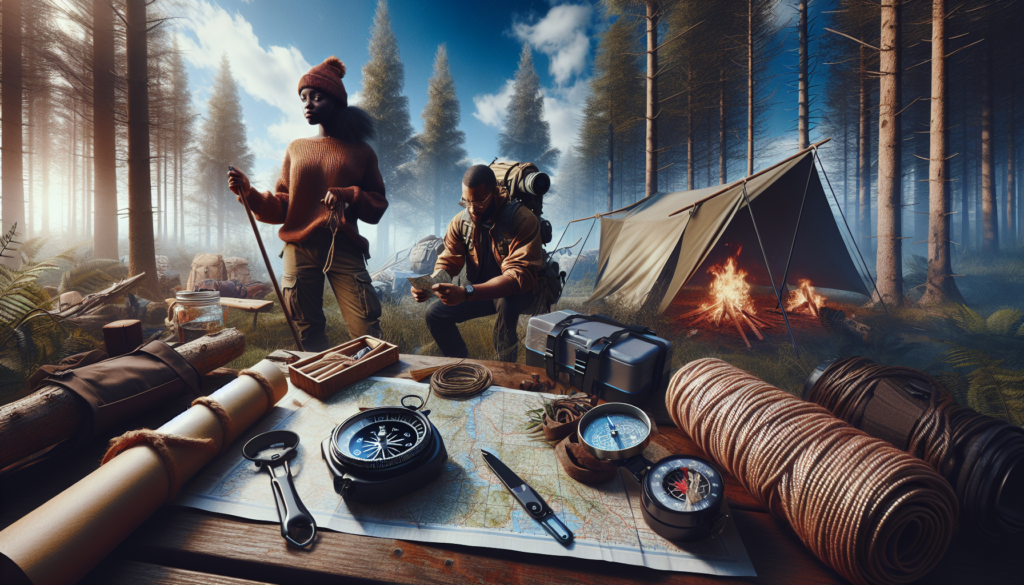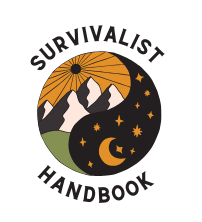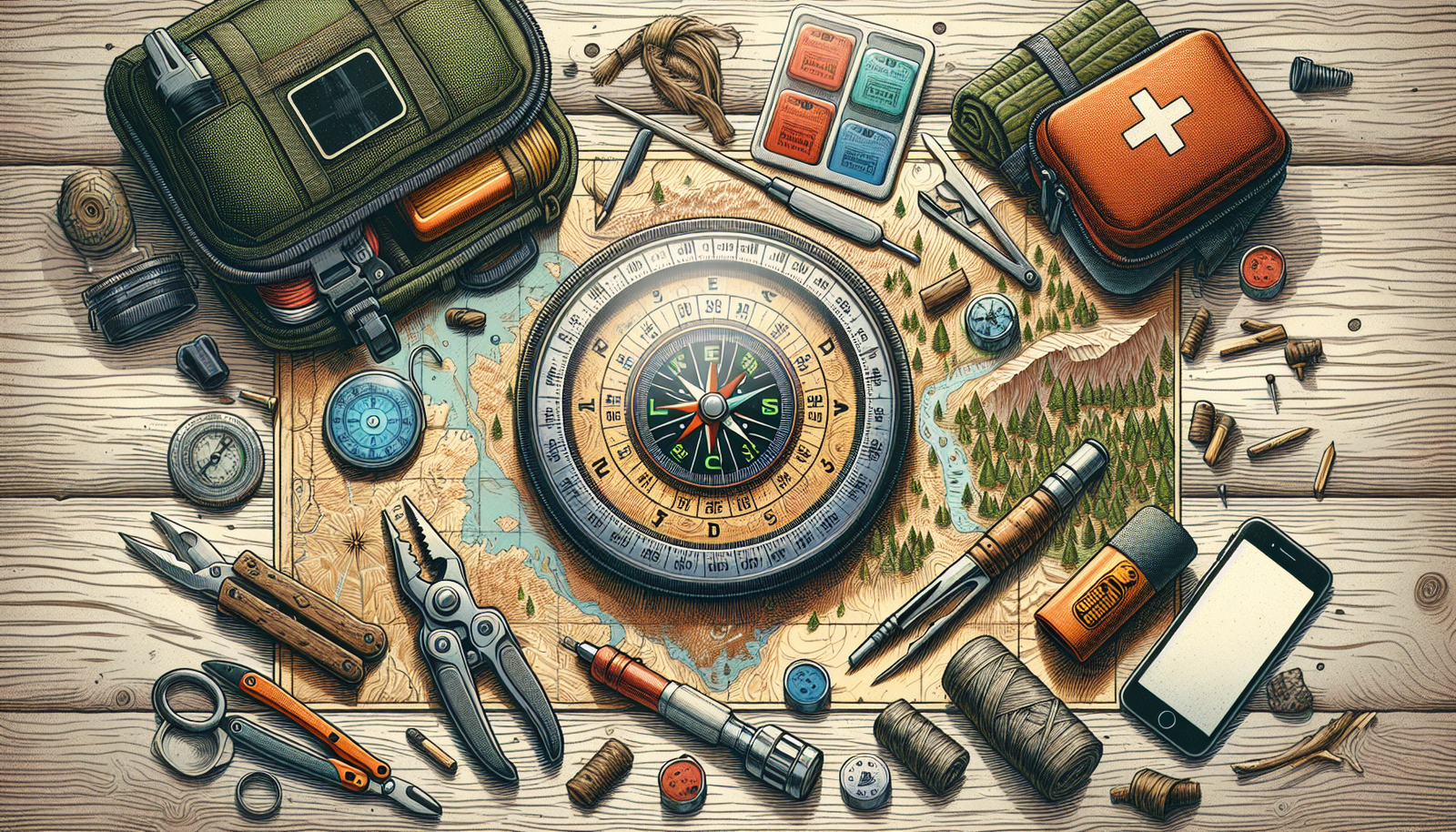In our ‘Basic Survival Skills’ section, you’ll find everything you need to know to navigate and thrive in the great outdoors. Whether you’re a novice or a seasoned adventurer, our comprehensive guide is here to help you master essential survival techniques. From learning the basics of outdoor survival to acquiring wilderness survival skills, our resources cover a wide range of topics. With our extensive ‘Survival Skills Checklist’, you can ensure you’re well-prepared for any situation that may come your way. Get ready to embark on an exciting journey of discovery and equip yourself with the necessary knowledge to embrace the challenges of nature. Welcome to the world of basic survival skills!
Outdoor Survival Basics
Welcome to our ‘Basic Survival Skills’ article, where we will guide you through essential outdoor survival techniques. Whether you’re a beginner or a seasoned adventurer, these skills are crucial for anyone venturing into the great outdoors. In this section, we will cover the fundamental aspects of outdoor survival, including finding shelter, building a fire, and locating water sources.
Finding Shelter
When it comes to survival, finding shelter should be your top priority. Exposure to the elements can quickly lead to hypothermia or heatstroke, so it’s vital to seek shelter from extreme weather conditions. Look for natural or man-made structures that can offer protection, such as caves, rock formations, or fallen trees. If no suitable shelter is available, you can construct one using branches, leaves, and other debris. Remember to choose a location away from potential hazards like dead trees or animal dens.
Building Fire
Fire is not only useful for keeping warm but also for cooking food, purifying water, and signaling for help. To start a fire, gather and arrange dry materials such as twigs, leaves, and bark. Create a fire pit away from flammable objects and build a small teepee or lean-to structure using the materials you collected. Use a fire starter, matches, or a lighter to ignite the tinder, and gradually add larger fuel as the fire grows. Always practice proper fire safety and extinguish the fire completely before leaving.
Finding Water
Water is essential for survival, and knowing how to find it in the wilderness is crucial. Look for signs of water, such as vegetation, animal tracks, or low-lying areas. Streams, rivers, and lakes are excellent sources, but be cautious and purify the water before consuming it. If you can’t find surface water, you can collect dew or rainwater using a container or set up a simple water condensation trap using a plastic bag and vegetation. Always prioritize water procurement to avoid dehydration.
Navigation Skills
Navigating through unfamiliar terrain is another vital skill for outdoor survival. When you’re lost or disoriented, having the ability to use a compass, read a map, or navigate by the stars can mean the difference between finding your way back or staying lost.
Using a Compass
A compass is a valuable tool for determining direction and maintaining your bearings. Begin by familiarizing yourself with the different components of a compass, such as the magnetic needle and the cardinal directions. To use a compass, hold it level and away from any metal objects or electrical devices that may interfere with its accuracy. Rotate the compass housing until the north end of the magnetic needle aligns with the red arrow in the housing. The direction of travel arrow on the baseplate of the compass will now indicate your desired direction.
Navigating with a Map
A map is an essential navigational tool that provides a visual representation of the area you’re in. Study the map beforehand to identify key landmarks, contours, and symbols that indicate terrain features. Orient the map by aligning its north-south grid lines with the compass needle. Use the compass to determine your general direction and follow the map’s routes, trails, or topographic features to reach your destination.
Reading the Stars
In the absence of a compass or map, knowing how to navigate based on celestial bodies can be invaluable. By familiarizing yourself with prominent constellations and stars, you can determine your direction at night. Identify the North Star, also known as Polaris, in the night sky, as it remains relatively stationary. Other constellations can also guide you, such as the Big Dipper, which points towards the North Star. Take note of the movement of stars throughout the night to estimate time and maintain your bearings.

First Aid and Medical Skills
Accidents and injuries can happen anytime, even in the wilderness. Having basic first aid and medical skills can mean the difference between a minor inconvenience and a life-threatening situation. In this section, we will cover CPR, treating wounds, and identifying poisonous plants.
CPR
Cardiopulmonary resuscitation (CPR) is a lifesaving technique used to revive someone whose heart has stopped. Learn the correct method for performing CPR, including chest compressions and rescue breaths. This skill can be essential in emergencies where immediate medical help is not available. Consider enrolling in a certified CPR course to gain hands-on training and certification.
Treating Wounds
In the wilderness, even minor wounds can lead to infection if not properly treated. Learn how to clean wounds, apply dressings, and administer basic first aid to prevent further complications. Carry a first aid kit with essential supplies like antiseptic wipes, bandages, adhesive tape, and sterile gauze pads. Additionally, familiarize yourself with the signs of infection and when to seek medical attention.
Identifying Poisonous Plants
While nature is full of beautiful plants and foliage, it’s essential to recognize and avoid poisonous plants. Educate yourself on common poisonous plants in the region you’ll be exploring, such as poison ivy, poison oak, or stinging nettles. Learn to identify their distinct features, including leaf patterns, colors, and any warnings they may offer. Knowing how to avoid contact with poisonous plants can prevent painful rashes, allergic reactions, and other health issues.
Food and Water Procurement
Sustenance is crucial in a survival situation, and knowing how to find food and purify water can keep you nourished and hydrated.
Finding Edible Plants
In the wilderness, numerous plants are safe to eat and can provide essential nutrients. However, it’s crucial to learn to identify edible plants accurately to avoid consuming poisonous ones. Study guidebooks or take courses on edible plant identification to acquaint yourself with the local flora. Learn about edible berries, roots, leaves, and other plant parts, as well as any preparation techniques necessary to make them safe for consumption.
Hunting and Fishing
If you have the necessary skills and equipment, hunting and fishing can provide a valuable source of food in survival situations. Learn about local hunting regulations and obtain any required licenses or permits. Familiarize yourself with hunting techniques, such as using traps, snares, or primitive weapons. If fishing is an option, learn to identify suitable fishing spots, set up fishing lines or nets, and effectively catch fish to sustain yourself.
Purifying Water
While finding water sources is crucial, it’s equally important to ensure the water is safe for consumption. Collecting water from lakes, rivers, or streams can expose you to harmful bacteria, parasites, or contaminants. Learn various water purification methods, such as boiling, filtering, or using water purification tablets. Each method has its advantages and disadvantages, so be prepared to adapt based on the resources available to you.

Building and Maintaining a Camp
Creating a suitable camp is essential for long-term survival in the wilderness. In this section, we will cover choosing a campsite, setting up a shelter, and campfire cooking.
Choosing a Campsite
When selecting a campsite, consider its proximity to water sources, availability of natural resources, and protection from the elements. Look for flat ground to set up your shelter and avoid areas prone to flash floods, falling rocks, or high winds. Also, be mindful of any wildlife activity or potential hazards in the vicinity. Taking the time to choose a suitable campsite can greatly enhance your comfort and safety in the wilderness.
Setting Up a Shelter
A shelter provides protection from the elements and can help regulate body temperature. Depending on the available resources, you can construct various types of shelters, such as a lean-to, debris hut, or tarp tent. Keep in mind factors like insulation, wind direction, and waterproofing when building your shelter. Practice setting up different types of shelters in advance to familiarize yourself with the process and optimize your chances of constructing a sturdy and comfortable shelter when needed.
Campfire Cooking
Cooking over a campfire not only provides nourishment but also boosts morale and creates a sense of comfort. Learn how to cook meals over an open fire, using methods like roasting, boiling, or grilling. Ensure you have the necessary cooking utensils and food preparation equipment in your survival kit. Mastering campfire cooking techniques will not only make your meals more enjoyable but also minimize the risk of foodborne illnesses.
Self-Defense and Personal Safety
While most outdoor adventures are safe, it’s essential to be prepared for potential risks and threats. Learning basic self-defense techniques, identifying and avoiding dangerous animals, and carrying personal protection tools can help ensure your safety in the wilderness.
Basic Self-Defense Techniques
Understanding basic self-defense techniques can help you defend yourself in emergency situations. Take self-defense classes to learn techniques like striking, blocking, and escaping from attackers. Additionally, familiarize yourself with basic situational awareness and personal safety practices to avoid confrontations whenever possible.
Identifying and Avoiding Dangerous Animals
Wild animals can pose a threat in certain areas, and knowing how to identify and avoid them is vital for your safety. Research the wildlife native to the area you’ll be exploring and learn their habits and behaviors. Respect their natural habitats and avoid interfering with their activities. Carry bear spray or other appropriate animal deterrents if necessary and follow guidelines for safe encounters if you come across potentially dangerous animals.
Personal Protection Tools
Carrying personal protection tools like whistles, air horns, or personal alarms can provide an added layer of security in the wilderness. These tools can be effective for signaling for help or deterring potential threats. Pepper spray or bear spray can also be useful against aggressive animals. Ensure you familiarize yourself with the proper use and local regulations surrounding these tools.
Emergency Signaling and Communication
In emergency situations, being able to signal for help and communicate can be a lifesaver. In this section, we will cover building a signal fire, using signaling mirrors, and radio communication.
Building a Signal Fire
A signal fire can attract attention and help rescue teams locate your position. Choose a visible location and gather material that produces a thick, dark smoke, such as green vegetation or rubber. Create a large and smoky fire using these materials, ensuring it remains visible and well-maintained. Carry fire-starting tools in your survival kit to increase your chances of establishing a signal fire quickly.
Using Signaling Mirrors
Signaling mirrors, also known as survival mirrors or heliographs, can reflect sunlight and transmit a visible signal over long distances. Learn how to use a signaling mirror effectively by angling it towards the target and directing the reflected light to the desired location. Practice signaling techniques in advance to become comfortable with using this valuable signaling tool.
Radio Communication
Having a reliable means of communication can significantly improve your chances of survival in an emergency. Carry a portable radio or a satellite phone in your survival gear and familiarize yourself with its operation. Prioritize contacting emergency services or search and rescue teams if needed, providing them with concise and accurate information about your situation and location.
Survival Knots
Knowing how to tie essential survival knots can assist in various situations, from setting up shelter to securing belongings. In this section, we will cover three fundamental knots: the square knot, bowline knot, and clove hitch.
Square Knot
The square knot is commonly used to join two ropes of equal thickness securely. It’s ideal for tying bandages, splints, or securing parcels. Cross one end of the rope over the other, then pass it under and over the second rope. Repeat the same process, but this time, start with the other end of the rope. Finish by tightening the knot by pulling both ends firmly.
Bowline Knot
The bowline knot creates a dependable loop that won’t slip or tighten under pressure. It’s useful for creating a fixed loop at the end of a rope or securing objects. To tie a bowline knot, create a small loop and pass the end of the rope through the loop. Bring the rope up behind the standing part, around the back of the original loop, and then back down through the loop. Tighten the knot by pulling the standing part and loop in opposite directions.
Clove Hitch
The clove hitch is a simple knot used to secure a rope to a post or pole. It’s easy to tie and untie, making it versatile for various applications. Begin by looping the rope around the post or pole, crossing the two ends over each other. Cross them over the post again, then pass the rope ends under the second horizontal line created by the initial loop. Pull both ends tightly to secure the clove hitch.
Wilderness Travel and Orientation
Navigating through the wilderness requires specific skills and an understanding of the surrounding environment. In this section, we will cover land navigation skills, route finding, and understanding topographic maps.
Land Navigation Skills
Land navigation skills involve the ability to read and interpret natural features of the land. Develop a keen sense of observation to identify landmarks, discern terrain changes, and assess your position accurately. Utilize techniques like using triangulation to determine your location based on known landmarks or employing dead reckoning to estimate your movements based on direction and distance traveled.
Route Finding
When traveling in the wilderness, route finding allows you to plan and follow the safest and most efficient path. Consider factors such as terrain, elevation changes, and potential obstacles when selecting a route. Take advantage of prominent landmarks, natural formations, or distinct trail markers to guide your path. Always have a backup plan and be prepared to adjust your chosen route based on changing circumstances.
Understanding Topographic Maps
Topographic maps provide detailed and accurate representations of the terrain, allowing you to plan and navigate effectively. Learn how to read contour lines, which depict elevation changes, and understand the scale and symbols used on the map. Familiarize yourself with key features such as ridges, valleys, and bodies of water. Topographic maps can be invaluable tools for orienting yourself, identifying potential hazards, and planning your wilderness travels.
Gathering and Foraging
Gathering and foraging skills enable you to source necessary resources directly from the environment. In this section, we will cover finding wild edibles, collecting firewood, and identifying medicinal plants.
Finding Wild Edibles
The ability to identify and gather wild edibles can supplement your food supply in a survival situation. However, it’s crucial to exercise caution and knowledge to avoid consuming potentially toxic plants. Learn to recognize edible plants, berries, nuts, and mushrooms specific to the region you’re in. Practice proper identification techniques, such as examining leaf shape, smell, and any safety precautions associated with each edible plant.
Collecting Firewood
Firewood is essential for maintaining a fire, providing warmth, and cooking food. Learn to identify and collect suitable firewood, such as dry branches, dead trees, or fallen timber. Gather wood from the ground rather than from living trees to preserve the environment. Understand the importance of using the Leave No Trace principles and avoid depleting limited resources by collecting only what you need.
Identifying Medicinal Plants
Nature provides various plants with medicinal properties that can aid in treating minor ailments or injuries. Familiarize yourself with common medicinal plants in your area and their potential uses. Learn to identify plants with antiseptic, antibacterial, or analgesic properties, as well as those that can help with digestive issues, allergies, or insect bites. Understanding how to identify and use these plants can prove invaluable when medical assistance is not readily available.
In conclusion, acquiring basic survival skills is essential for anyone spending time in the great outdoors. From finding shelter to navigating unfamiliar terrain and treating injuries, each skill contributes to your safety and well-being. By learning these skills, you can increase your confidence and ensure that you’re prepared for any situation that may arise in the wilderness. Remember, practice and preparation are key to mastering these survival techniques, so get out there and explore while keeping these skills in mind!

